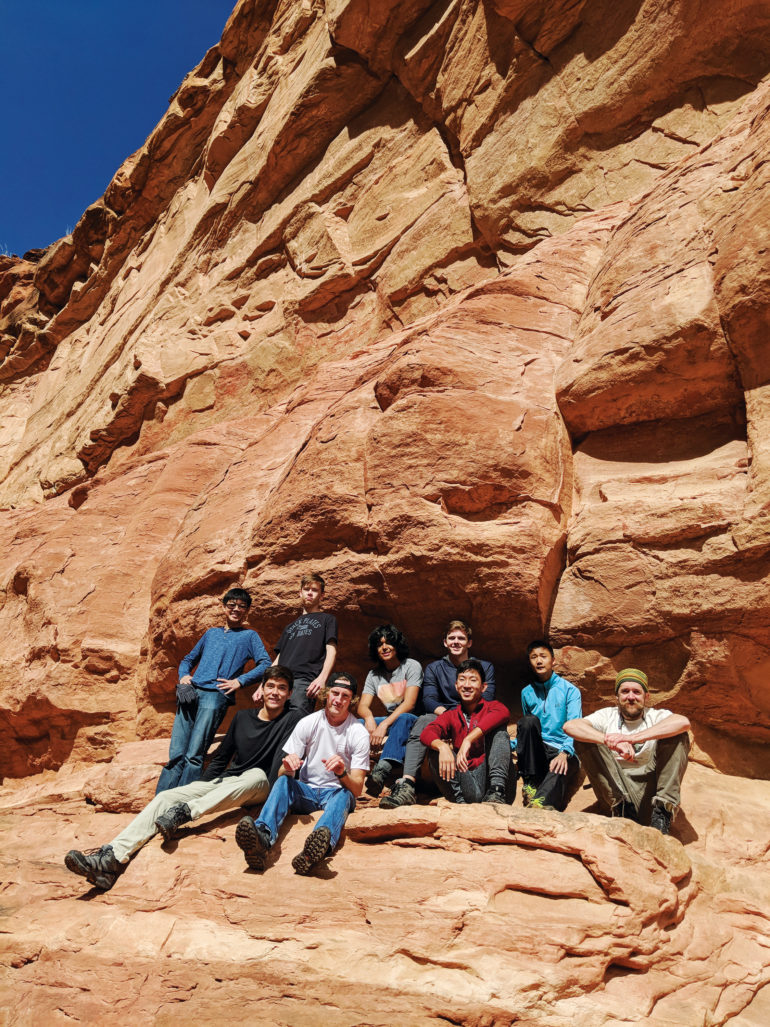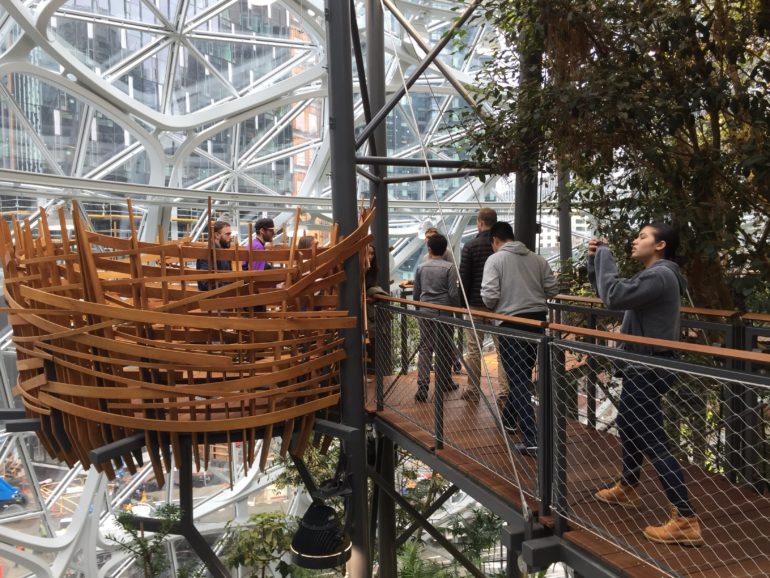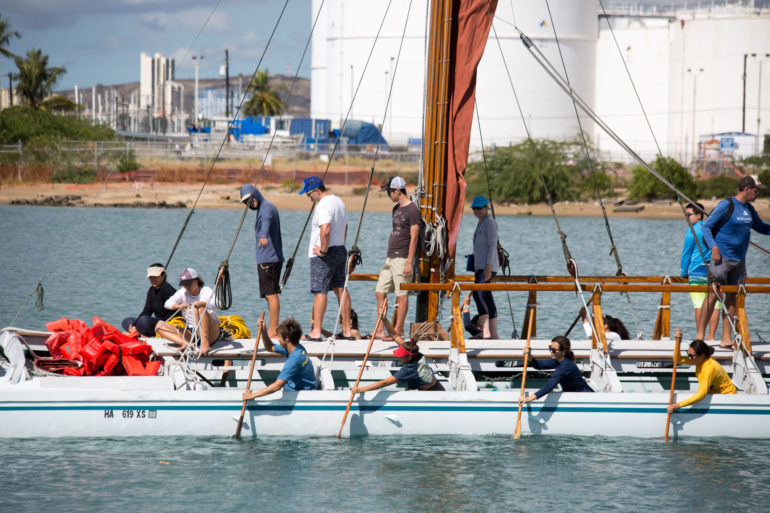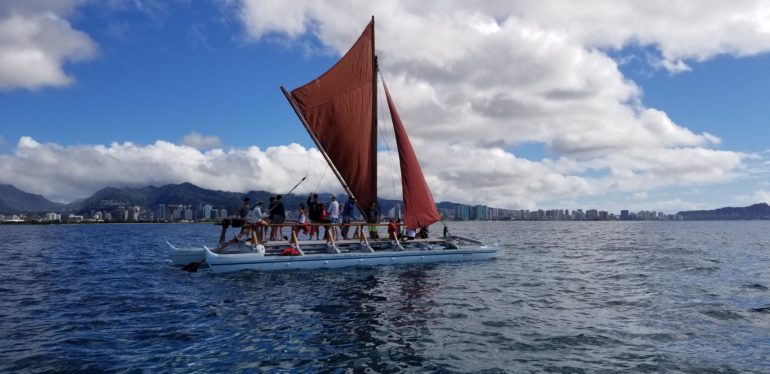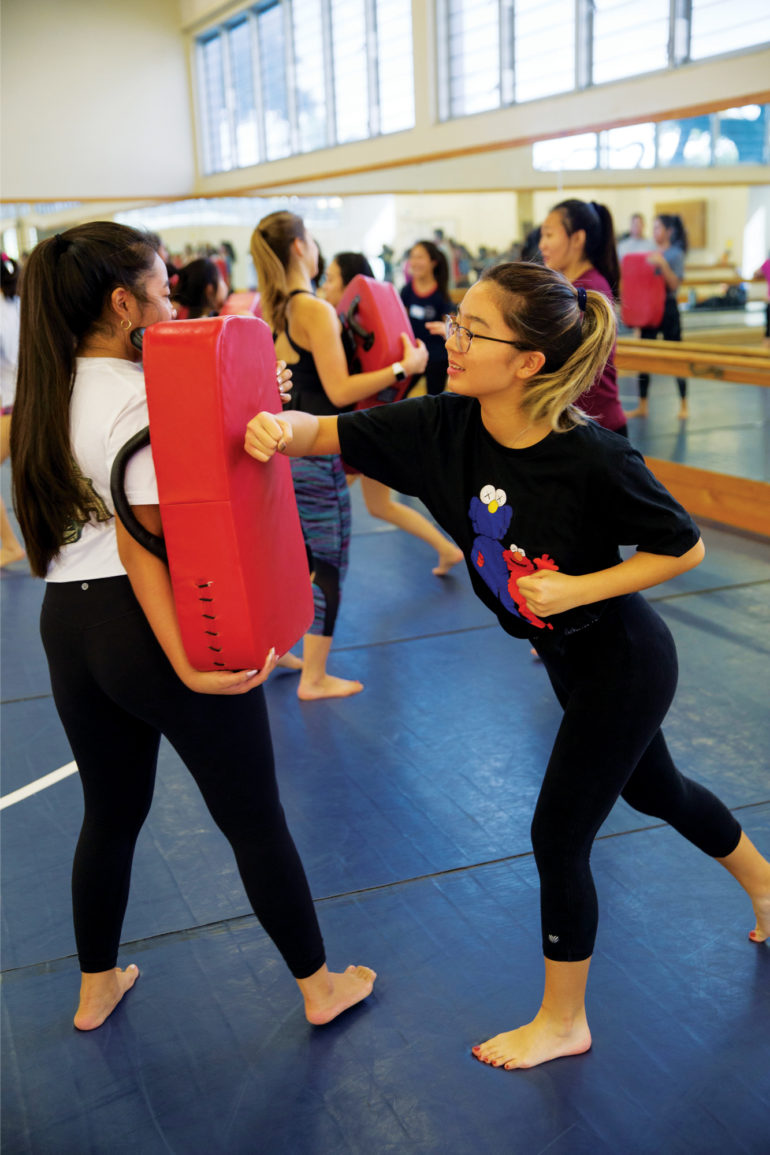By Rachel Breitweser ’03

Six spirited dogs trot across Punahou’s Rice Field, eagerly keeping pace with those learning to train them. At Ala Moana Beach, Academy students help disabled swimmers enjoy the ocean in beach wheelchairs. Five thousand miles away, other students shape taro dumplings in a kitchen in Taiwan.
These were among the experiences that unfolded during the 2019 Academy G-Term, during the four-day interim in early January, between winter break and second semester. Students in grades 9 – 12 participated in 80 courses offered on campus, across O‘ahu, on Maui and Moloka‘i, as well as in such places as Seattle, Boston, Washington, D.C., Guadalajara, Mexico and Taiwan. While some explored the outdoors, others delved into Hawaiian culture, the arts, community service, social responsibility, cultural awareness, history, technology and life skills.
Now in its third year, G-Term has become a critical piece of the Academy experience that students and teachers look forward to, according to Academy Principal Emily McCarren. It’s a change of pace from the School’s regular academic environment.
“Creating alternate experiences for students where they can explore something deeply and seek meaningful transferable learning outcomes is exciting for everybody,” McCarren said.
Teachers practice backwards design when conceptualizing the courses, starting with the Aims of a Punahou Education, then creating activities to support those objectives. With this approach, students learn collaboration; critical and creative thought; curiosity; diversity; empathy; Hawaiian values and culture; persistence and resilience; resourcefulness; social responsibility; and engaged citizenship.
While the activities are meant to be fun and engaging, they serve a greater purpose in the community and for the School, said Trisha Kawamoto ’98 Caley, director of Academy special terms. “That makes the experience even more worthwhile,” she said. “Some of the opportunities that are available to students in this particular program, we can’t replicate them at other times of the year, and they could possibly not be replicated ever. That’s what makes the program unique. There’s something special about students getting out and being able to experience something on their own.”
Three days in the Boston area
Cambridge Innovation and Entrepreneurship
Students visited Massachusetts Institute of Technology (MIT), Harvard University, Amazon Robotics, Boston University and the Museum of Fine Arts, Boston to take part in a wide range of activities with other students, Punahou alumni and researchers. They learned how research is conducted in major universities, how promising ideas are developed, and about the university admissions process.
By Briahni Alejo ’20
I loved Boston, every bit of it. Our first class was at MIT. Sitting inside an MIT classroom, you feel so smart. I thought, ‘Okay, I can totally picture myself here.’ We did strobe photography and laser reflection. We set up mirrors and then reflected the laser through a maze.
My impression was that I was going to stay in my shell, not talk to anyone, and just sit and learn, but they made it so comfortable, where it was like we were attending MIT and we were the class of 2020 at MIT. It was super exciting!

The following days, we went to makeries at Harvard, Boston University and MIT. The different universities all reflected or resembled Punahou in a way. They felt homey and familiar. It was interesting to see that what we have here at the D. Kenneth Richardson ’48 Learning Lab, they have in their makeries too. Students here are producing the exact same things as students in college.
The whole trip was about new experiences. The trip was a good opportunity to meet fresh minds and learn about other people’s perspectives and backgrounds. We met a lot of alumni who own businesses. When they were explaining what they do, it was inspiring because these people are their own bosses, and that’s exactly what I want to strive for. I can totally see myself being in their positions.
Course led by Academy math teacher Douglas Kiang ’87 and director of academic and auxiliary services and college counselor Lynne Tsuda ’74
Three days at Ala Moana Beach, Kaimana Beach and Kahuku Beach
Become a Better Beachgoer
Students discovered empathy for themselves and others by engaging in fun, ocean-related community-service activities, including a volunteer event at Ala Moana beach with AccesSurf, an organization that helps disabled people experience the ocean.
By Madisyn Beirne ’20
At the AccesSurf event, we helped a man named Robert, who was paralyzed in an accident. The first step was to transfer him from his wheelchair to one with big tires that’s adapted for the sand and beach. A group then helped wheel him into the water, deep enough for him to float free and swim. I swam with Robert, along with another student, to make sure he was safe and to keep him company.
Robert told us about his life before his accident – his love of the sand and water and his favorite beaches in Mexico. That day, when Robert was able to get back into the water, it was like he got back something he had lost. Sharing that moment with him was special.

I didn’t know what to expect when we showed up to AccesSurf. I hadn’t previously met people who can’t get in the water when they want to. Meeting Robert helped me realize the power of perseverance, being strong and never giving up on what you love.
Since the day at the beach, I feel really grateful for what I have. Sometimes I just want to say, ‘I can’t do that.’ But now I know I can.
Course led by Academy science faculty Ali Marumoto ’89
Three days at Marine Education Training Center, Sand Island and Punahou Campus
Try Voyaging
Students learned the basics of seamanship, safety and voyaging canoes, toured the deep-sea wa‘a Hōkūleʻa, Hawai‘i Loa and Hikianalia, and learned to sail the coastal canoe Kamaʻuheuheu.
By Kaimana Drago ’19
There’s something about being on the ocean and looking out away from land. You’re away from stress, hustle and homework. When I go paddling and surfing, I feel free. You’re in a different head space. The only thing you really care about is what you’re doing in the moment, and you don’t have to worry about the test tomorrow. It’s freeing. That’s why I signed up for this course – to be in the ocean. Sailing, though, was a new experience for me.
Sailing is different than paddling in that it’s less physically demanding, but you still have to pay attention to the winds, currents and waves, and know when to tack, how to steer and hold the lines to the sails. Doing it for one or two days was definitely fun, but going from Tahiti, traveling thousands of miles, like the Hōkūleʻa crew – it’s insane. Kaniela was talking to us about co-captaining the last leg of Hikianalia’s return to Hawai‘i, which was from San Diego. That’s great. It would be a dream to do a Hōkūleʻa or Hikianalia voyage.

I’ve been thinking about this quote: ‘One hundred percent of me is nothing compared to one percent of the entire team.’ It’s the idea that you can give as much as you can give, but a team can give so much more. I started to think about the rigging. One person could not do that; one person could not hold up the mast – it’s impossible. But it was made so easy by everyone. It felt good to know we all had the same goal.
Academy faculty Adam Jenkins and dean Lisa Stewart led the experience, accompanied by Junior School faculty Kaniela Lyman-Mersereau ’05
Seven days in Seattle area
STEM and Social Responsibility in Seattle
Students learned about ways that organizations practice social responsibility, investigated the natural and designed world, and met people working in STEM fields, including Punahou alumni. Students visited Amazon, Boeing, Google, Microsoft, Oculus and Bungie, learning how some of the world’s most innovative companies tackle real-world problem-solving.
By Carson Loughridge ’22
I went on this STEM trip to figure out what I want to do. I’m curious about everything, and most curious about mixed reality, augmented reality and virtual reality. One of my favorite experiences on the trip was testing out the Oculus VR. It’s one thing to do it, but to see where it’s built, how it’s built and then experience it – it was really fun! I can totally see where VR is going, and that’s amazing.
At many of the places we visited, we talked with the people who worked there, which was definitely the highlight. I got a lot of questions answered. There were some answers that I wasn’t expecting that were really awesome. I made a connection with one of the Punahou graduates who works at the Bill & Melinda Gates Foundation. He is part of the department of education, and we talked about augmented reality and how you can use these technologies to educate kids. That’s one of my passions.

Everything was really amazing, and the trip was so full of activities. Mentally, you’re just really jazzed. You get all these big ideas from companies that you visit, but then also during the downtime with your new friends, you talk about what happened during the day and reflect on it. I will remember this my whole life.
Course led by Academy Science faculty Reid Hayes ’09, Director of Professional Programs Anna Liem ’93, Innovation Catalyst Wendi Kamiya and Director of Extended Learning Jon Koshiba ’94.
Seven days in Arizona and Utah
Active Science in the American Southwest: Grand Canyon, Bryce and Zion National Parks
Students journeyed to the American Southwest to explore three national parks. They learned about the geology and ecology of the region, which is very different than tropical Hawai‘i, and studied astronomy at a renowned observatory.
By Kamalu Ogata ’21
Bryce Canyon was the first canyon we visited. Looking down through it was really pretty. There were so many hoodoos, which are rock spires that connect together and have a variety of animals living there, like bats, rats and prairie dogs.
The Grand Canyon was also inspiring. During the first few switchbacks going down, you look down, and it’s super deep. A few parts were steep, but it wasn’t scary. And it was fun hiking in snow. We hiked in three different environments, from where alpine trees grow, down to junipers, to a place that didn’t even have snow. It was amazing just looking at all these things that are so different from where we live, and experiencing the range of environments. Everything was new.

We also went to Antelope Canyon. It’s really cool because it just spreads out as if it’s neverending, with curves and shades of reddish brown.
For the astronomy part of it, we went to Lowell Observatory in Flagstaff. They have all these different telescopes. We looked at a nebula and Saturn’s rings. You could see orange and red when looking at the planets. It was very cool and pretty.
I know I can always go to the Grand Canyon or Antelope Canyon again, but it’s not going to be the same as the first time you see it, and how in awe you were when you looked down the canyon or up into the night sky in Flagstaff. It’s surreal, as if you’re living in a picture or a fantasy.
Course led by Academy science faculty Dan Gaudiano and Tiffany Coke
Three days on Punahou Campus
Women’s Self-Empowerment Through Self-Defense
Students practiced real-life, hands-on strategies for self-protection, confidence, resilience and awareness through the martial art of Krav Maga, yoga and mindfulness.
By Ondine Berg ’19
I started off not knowing anything. We had to punch and kick heavy pads, which was intimidating at first, but I was motivated to get better, so if I ever to find myself in a bad situation, I can defend myself, which is the ultimate skill.
On the last day, we had to go up against three Krav Maga instructors to test our skills. Krav Maga is a self-defense and fighting system that incorporates techniques of boxing, wrestling, Aikido, judo and karate.

My adrenaline was going at the sight of three guys in padded suits. Their job was to scare us and simulate an attack. I was nervous, but once I was one-on-one against them, I threw my elbows and kicked. I got out of a choke hold. I felt so powerful. It felt amazing to know that I could fight against them.
Overall, the three days were awesome. The course has made me more confident. Walking down the street now, I feel safer and more comfortable.
This G-Term course was probably the most useful experience I could have had as a female. These are useful skills everyone should have. It inspired me. Now, I’m in contact with school leaders and faculty to see if we can incorporate self-defense in the PE curriculum. Just imagine how much safer all the students here would feel when they went off to college.
Course led by Academy English faculty Deira Akiyama ’84 Itagaki and Alison Lazzara ’93

